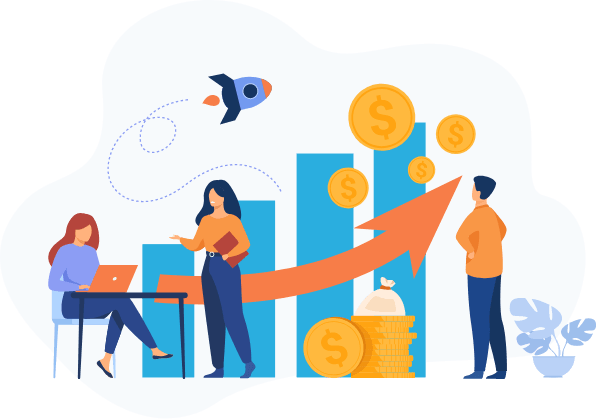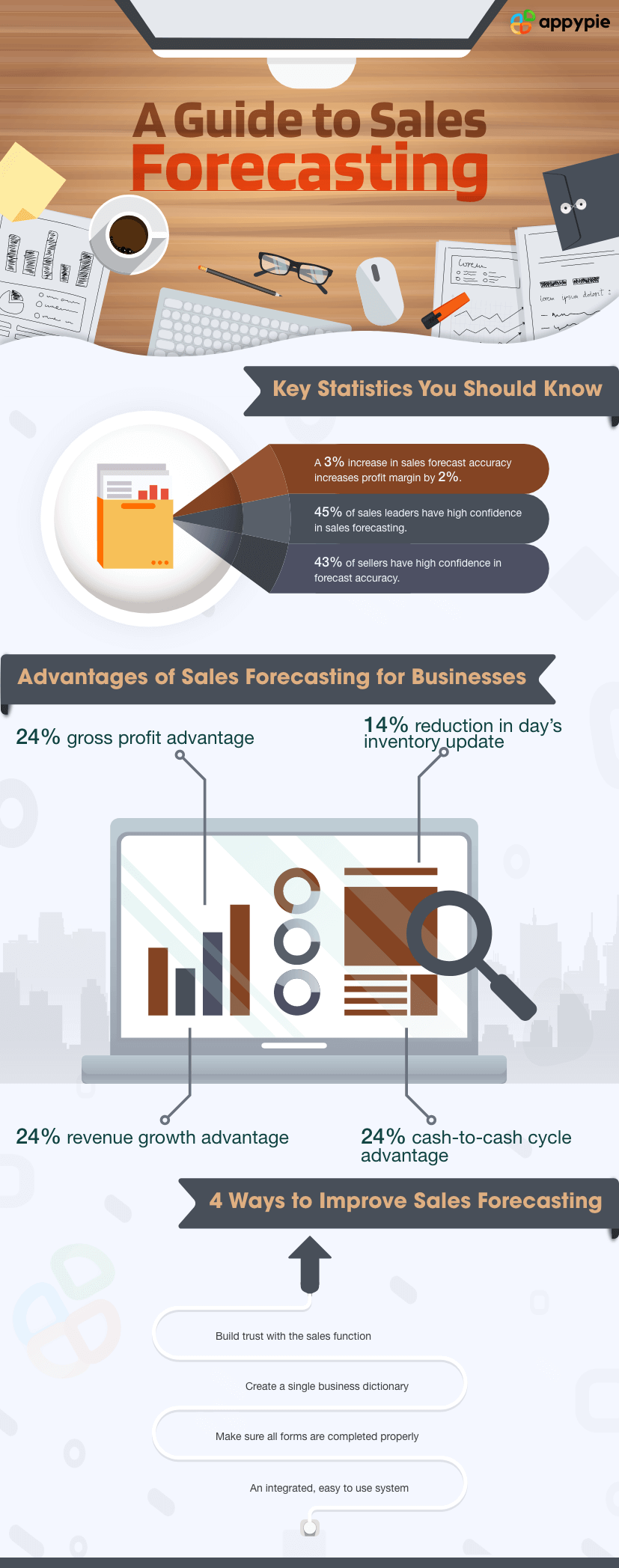Sales forecasting is the process of estimating potential sales of a product or service. It helps businesses and sales individuals make accurate assumptions and predict if they will meet the required sales quota or not.
Accurate sales forecasting allows salespeople and businessmen make better decisions, set realistic goals, and ensure growth for their organization.
Table of Contents
However, most businesses and salespeople struggle to forecast sales accurately. Usually, their predictions are way too optimistic and unrealistic.
This article is a simplified guide to help you learn about forecasting sales for your business, sales forecasting templates you can use, and why sales forecasting is important for the growth of your business.
The Importance of Accurate Sales Forecasting
An achievable goal is a very necessary and important part of the sales process. An accurate sales forecast helps you leverage the oodles of data you have collected and utilize them to set realistic goals for your sales teams.
Forecasting helps set goals and spot shortcomings in your sales strategies. For example, if your competitor has a history of offering discounts during festive seasons, you can also offer similar discounts and more by studying your sales forecasts.
Sales forecasts help you make big business decisions. For example, if you predict sales lower than your targets, you can start recruiting more salespeople or bump up marketing costs to draw more leads into your funnel.
Forecasting sales can also help drive up motivation among your employees. A good sales forecast helps reiterate the faith you have in your sales employees. The infographic below sheds light on a few important sales forecasting statistics.
What Factors Affect Sales Forecasts
No matter how good you are with your sales forecasts, there will always be a little discrepancy in your forecasts and goals achieved. Even the most accurate forecasts will have 5-10% of error. To ensure that you get to this level of accuracy, you must take into account certain factors that affect sales.
Here are some of those factors:
- Employee strength: People make up a company. The more sales employees you have, certainly more you will sell. Letting go of employees can also affect your sales numbers.
- Change in strategy: Every business has a sales strategy. These strategies affect your sales big time. For example, if you offer discounts to increase sales near the end of the month, make sure to compensate for the rise in sales when you make a forecast.
- Product changes: The products you sell will get updated with time. For example, new features in your products that customers requested you to add. Such product changes will directly affect your sales.
- Market demands: If your products start falling out of favor in the market or a new product gains popularity, your sales will be affected. Do proper market research before you make a sales forecast to avoid nasty surprises.
- Competition: Depending on what your competition does, your sales forecasts will be affected. For example, if your competitor announces a major discount, it will affect your sales indirectly.
- Government laws: Government laws can directly drive your sales. If there is a change in regulation or laws in the country you operate in, adjusting your sales forecasts accordingly is necessary.
- Seasonality: Depending on your business, seasonal changes might be a factor. For example, automobiles sell more around the festive season, winter clothes get most of their sales during autumn months, etc. Account for seasonal changes in your forecasts.
The Various Methods to Forecast Sales
There are various methods to forecast sales for your business.
- Stage-based forecasting:
- Sale Age forecasting:
- Historical forecasting:
- Intuitive forecasting:
- Analytical forecasting:
Stage-based forecasting is forecasting sales based on the various steps in your sales strategy. Depending on the business you are in, there may be multiple stages or a sales pipeline in your sales process.
For example, the automotive industry is one of the industries where stage-based forecasting is common. The sale of an automobile involves the following processes: Customer inquiry, test drives, purchase requirements(variants and addons), deposit & financing, delivery & PDI checks, and final payments.
In stage-based forecasting, a salesperson can estimate the success rate. Each stage of the sales process has a different rate of success. Stage-based forecasting is the easiest way to forecast sales.
However, this form of forecasting is often inaccurate and does not account for the time a deal takes or the amount of money involved in a deal. For example, it will be easier to sell a small automobile compared to a luxury car even if the predicted success rate is the same.
Time is money. However, too much time spent on one deal can often not lead to money. Sale age forecasting uses the length of your sales cycle as a reference to make predictions for your sales.
Based on how much time your rep has spent with a customer, the success rate rises or falls for such sales. Just like stage-based forecasting, this method is objective and does not take into consideration the amount and size of a particular sale.
This forecasting also needs to identify the source of a sale and must be adjusted to the various sales strategies and channels you use. For example, a direct lead will take more time to close whereas a referral lead will close faster. But if your sales rep personally meets the buyer, the sale will likely be faster.
The only way to ensure that you can forecast using this method accurately, you need to track your rep’s data with a CRM and you must automatically record their interactions.
To achieve this you will need a way to integrate your CRM with communication as well as analytical software automatically. If you do not have a way to achieve this, your sales reps may spend a lot of time manually entering such data. You can use a workflow automation tool like Appy Pie Connect to automate this data exchange and improve your forecasts.
Historical forecasting is an old-fashioned way to forecast your sales. Historical forecasting uses past data for a selected time period and predicts equal or greater sales for the current time period. For example, if you want to forecast sales for June 2022, you can look at June’s sales data for the years 2018-2021 and make a prediction.
The problem with historical forecasting is obvious. It doesn’t take into account product changes, market perception, market demand, seasonality, or competitor strategies into account.
Despite its major flaws, this kind of forecasting works for stable markets and industries since it relies on proven existing data. However, historical data should rather be used for benchmarking sales performance instead of predicting sales.
This kind of sales forecasting requires you to have a little faith in your sales employees. It’s also the simplest kind of forecasting. Ask your sales reps to estimate the likelihood of a sale.
Your sales reps that communicate with leads will have a better grasp of who will buy and who will not. Intuitive forecasting is based on the opinions of your salespeople. Your salespeople will likely be over-optimistic about their sales. Their assessment might occasionally be wrong.
Intuitive forecasting works best when your company is new and growing. As a sales team expands, intuitive forecasting will start falling short.
Analytical forecasting is a data-driven forecasting method that takes everything from stages to customer rep productivity into account to make a forecast. However, it tends to be very accurate.
Since analytical forecasting has to balance so many variables, you need an advanced analytics & sales forecasting software solution that might be expensive. The success of analytical forecasts depends on the data you have available at hand. Without data, analytical forecasting can fall short.
You must keep an accurate track of each sale’s data. A workflow automation solution like Appy Pie Connect can help you achieve this. For example, you can record all your data into Google Sheets automatically with the help of simple automated integrations. Connect offers hundreds of integrations for Google Sheets. Check them out!
Sales Forecasting Template
To help make it easier to forecast your sales, we have designed a sales forecasting template that will help you get started. This template can help you:
- Track your business dealings
- Assign priorities to your deals
- Predict your revenue
- Plan future sales
You can download our template from the link below:
Conclusion
Sales forecasting is important for businesses around the world. Be it a startup or an established firm, accurate sales forecasts help provide a direction and goal for a business.
Start forecasting today!
Leave us a comment if you have any questions regarding forecasting. We will answer them for you!


